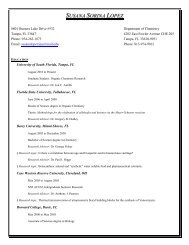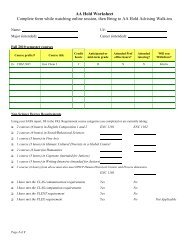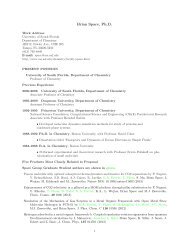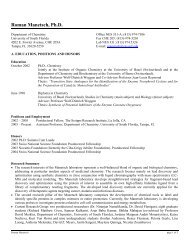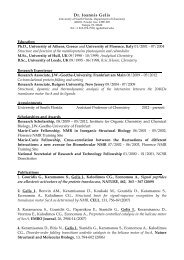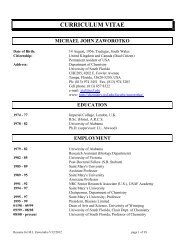1 CURRICULUM VITAE 10/05 Mildred Acevedo-Duncan - Chemistry ...
1 CURRICULUM VITAE 10/05 Mildred Acevedo-Duncan - Chemistry ...
1 CURRICULUM VITAE 10/05 Mildred Acevedo-Duncan - Chemistry ...
You also want an ePaper? Increase the reach of your titles
YUMPU automatically turns print PDFs into web optimized ePapers that Google loves.
<strong>CURRICULUM</strong> <strong>VITAE</strong> <strong>10</strong>/<strong>05</strong><strong>Mildred</strong> <strong>Acevedo</strong>-<strong>Duncan</strong>Present AddressPersonal Data:1301 Williams Road Citizenship: AmericanPlant City, FL 33565Birthplace: Puerto RicoPhone: Home; (813) 754-8616Office: (813) 972-2000 ext. 6967Objective:My current research interest involves intra and inter-cellular regulation; specifically howtransmembrane signals from hormones, growth factors and drugs regulate normalcellular function and how dysregulation at the receptor, second messenger or genomiclevels leads to abnormal cell interactions and cellular malignancy. In-vivo and in-vitroexperimental cancer therapies (single and combined modality treatments), tumorbiology, radiation biology, flow cytometry, cell cycle analysis, and cyclins. My goal is tobe an oncology research investigator working in a university setting and to teachbiochemistry, general and cell biology courses.Key Words: cell biology, oncology, protein kinase C, glioma, cell cycle, cyclins,cyclin dependent kinases.Education:Assistant Professor(1991-present) University of South Florida,Tampa, FL (813) 972-2000 ext 6967Principal Investigator, Merit Review Research Program, James A. Haley VeteransHospital, Tampa, FL.Research: Action of radiation on glioma protein kinase C and cell cycle.Postdoctoral Research Associate:(1988-1991) University of South Florida and VA Hospital, Tampa.(813) 972-8426, Ext. 2942Postdoctoral Mentor: Santo NicosiaResearch: Ovarian PathologyPostdoctoral Research Associate:(1987-1988) VA Hospital, Tampa. (813) 972-20001
CV: <strong>Mildred</strong> <strong>Acevedo</strong>-<strong>Duncan</strong>, PH.D.Postdoctoral Mentor: Robert V. FareseResearch: Insulin action on protein kinase C in BC3H-1 myocytes.<strong>10</strong>/20<strong>05</strong>Postdoctoral Research Associate:(1986) University of South Florida, Tampa. (813) 974-3393Postdoctoral Mentor: Ken KellerResearch: Regulation of glycoprotein biosynthesis (vitellogenin in Xenopus laevis) andmolecular cloning of the ovomucoid gene.Special Training: Recombinant DNA technology.Postdoctoral Research Associate:(1985-1986) University of Florida, Gainesville, FL (904) 392-3541Postdoctoral Mentor: David SilvermanResearch: Isolation and purification of Chlorella vulgaris carbonic anhydrase.Special Training: Mass spectrometric techniques to determine kinetic constants for thecarbonic anhydrase catalyzed reaction.Foreign Travel: (1984-1985) Resided in Senegal, West Africa where my husband wasemployed as a research plant pathologist. We returned to the United States due to thescarcity of cell biology research positions in Senegal.Ph.D.: (1979-1983) University of California, RiversideMajor Professor: Edward J. Carroll, Jr.Dissertation: Isolation of an operationally defined sea urchin vitelline envelope withsperm receptor activity and immunological evidence for a sperm receptor polypeptide.Coursework: Emphasis on advanced topics in fertilization.Special Training: Physical and biochemical isolation procedures. Scanning electronmicroscopy and immunofluorescent techniques.Master of Arts in Biology: (1977-1979) University of California, RiversideMajor Professor: Edward J. Carroll, Jr.Thesis: Effects of ozone on sea urchin fertilization and early development.Coursework: Cell biology, genetics, embryology and experimental cytology.Independent study and research in sea urchin fertilization and early development.Special Training: Transmission electron microscopy.Bachelor of Arts: (1973-1974) University of California, San Diego, Revelle CollegeCoursework: Emphasis on cellular and molecular biology. Independent study in cell2
CV: <strong>Mildred</strong> <strong>Acevedo</strong>-<strong>Duncan</strong>, PH.D.<strong>10</strong>/20<strong>05</strong>biology. Minor in psychology.Manuscripts in PreparationWhelan, S., Slawson, C., <strong>Acevedo</strong>-<strong>Duncan</strong>, M., and Potter, R. (20<strong>05</strong>) Increased ProteinMonoglycosylation in EGF stimulated MDA-MB-468 and SK-BR-3 Breast Cancer CellLines Leads to Changes in MAPK Activation.Whelan, S., <strong>Acevedo</strong>-<strong>Duncan</strong>, M., and Potter, R. (20<strong>05</strong>) A novel MAPK (ERK-4) presentin higher quantities of human breast tissue and breast tumor derived cell lines.Publications:Rekha, P. and <strong>Acevedo</strong>-<strong>Duncan</strong>, M. (20<strong>05</strong>) Detection of protein kinase C-ι as a markerfor brain tumorigenesis. Submitted to European Journal of CancerMatthews, J.A., Belof J., <strong>Acevedo</strong>-<strong>Duncan</strong>, M., and Potter, R.L. (20<strong>05</strong>) Differentialactivation of Akt in response to increasing intracellular O-GlcNAc levels in humantransformed glial cells. Submitted: Biochem. Biophys. Acta.Russell, C., and <strong>Acevedo</strong>-<strong>Duncan</strong>, M. (20<strong>05</strong>) Effects of PD 406976 on cell cycleprogression, proliferation, PKC isozymes and apoptosis in glioma and SVG transformedglial cells. Cell Proliferation 38:87-<strong>10</strong>6.Matthews, J.A., <strong>Acevedo</strong>-<strong>Duncan</strong>, M., and Potter, R.L. (20<strong>05</strong>) Selective down-regulationof PKC-α and PKC-ε due to elevated intracellular O-GlcNAc levels in SVG cells.Biochem. Biophys. Acta. 1743: 3<strong>05</strong>-315.Bicaku, E., Patel, R., and <strong>Acevedo</strong>-<strong>Duncan</strong>, M. (20<strong>05</strong>) Cyclin dependent kinase activatingkinase co-localizes with protein kinase C-ι in human glioma cells. Tissue and Cell 37:53-58.<strong>Acevedo</strong>-<strong>Duncan</strong>, M., Russell, C., Patel, S. and Patel, R. (2004) Aloe-emodinmodulates PKC isozymes, inhibits proliferation, and induces apoptosis in U-373MGglioma cells. Interna. Immunopharm. 4:1775-1784<strong>Acevedo</strong>-<strong>Duncan</strong>, M., Patel, R., Whelan, S. and Bicaku, E. (2002) Human glioma PKCιand PKC-βIl phosphorylate cyclin dependent kinase activating kinase during the cellcycle. Cell Proliferation 35:23-36.Publications:3
CV: <strong>Mildred</strong> <strong>Acevedo</strong>-<strong>Duncan</strong>, PH.D.<strong>10</strong>/20<strong>05</strong><strong>Acevedo</strong>-<strong>Duncan</strong>, M., Pearlman, J., and Zachariah, B. (2001) Sensitivity of humanglioma U-373MG cells to radiation and the protein kinase C inhibitor, calphostin C.Cell Proliferation 34:31-41.Bicaku, E., and <strong>Acevedo</strong>-<strong>Duncan</strong>, M. (2001) Ultrastructural study of protein kinase Clocalization during the cell cycle of human glioma cells. Tissue & Cell 33:55-62Bai, W., Oliveros-Saunders., Wang, Q., <strong>Acevedo</strong>-<strong>Duncan</strong>, M.E., Nicosia, S.V. (2000)Estrogen stimulation of ovarian surface epithelial cell proliferation. In Vitro CellDevelopmental Biology - Animal 36:657-666.Yamamoto, M., <strong>Acevedo</strong>-<strong>Duncan</strong>, M., Chalfant, C., Patel, N.A., Watson, J.E. andCooper, D.R. (2000) Acute glucose induced down regulation of PKC-βII acceleratescultured vascular smooth cell proliferation. American Journal of Physiology279:C587-C595.Cooper, D.R., Watson, J., Patel, N. Illingworth, P. <strong>Acevedo</strong>-<strong>Duncan</strong>, M., Goodnight, J.,Chalfant, C., and Mischak, H. (1999) Ectopic expression of Protein kinase c-βII, -δ and-ε, but not βI or -provide for insulin stimulated glucose uptake in NIH-3T3 fibroblasts.Archives of Biochemistry and Biophysics 372: 69-79.Yamamoto, M., <strong>Acevedo</strong>-<strong>Duncan</strong>, M. Chalfant, C., Patel, N.A., Watson, J.E. andCooper, D.R. (1998). The roles of protein kinase C βI and βII in vascular smoothmuscle proliferation. Experimental Cell Research 240:349-358<strong>Acevedo</strong>-<strong>Duncan</strong>, M., Zhang, R., Cooper, D.R. and Greenberg, H.(1997) Effects ofinterferon and PKC modulators on human glioma protein kinase C, cell proliferation andcell cycle. Neurochemical Research 22:775-984<strong>Acevedo</strong>-<strong>Duncan</strong>, M., Collins, J., Zhang, R., Haller, E., Chalfant, C., and Cooper, D.R.(1995) In-situ effects of interferon on human glioma protein kinase C-α and -βultrastructural localization. Cell Growth and Differentiation 6: 1353-1365.<strong>Acevedo</strong>-<strong>Duncan</strong>, M., and Zhang, R. (1994) Heterogeneity of protein kinase C activityin human U-373 and G-26 glioma cells. Biochem. Biophys. Res. Commun. 2<strong>05</strong>:127-134.Publications:Cozza, E.M., M. Vila, M. <strong>Acevedo</strong>-<strong>Duncan</strong>, R.V. Farese and C.E. Gomez-Sanchez.(1990) Treatment of primary cultures of calf adrenal glomerulosa cells with ACTH andphorbolesters. A comparative study of the effects on aldosterone production on ACTH4
CV: <strong>Mildred</strong> <strong>Acevedo</strong>-<strong>Duncan</strong>, PH.D.<strong>10</strong>/20<strong>05</strong>signalling system. Endocrinology 126:2169Cozza, E. N., M. del Carmen Vila, M. <strong>Acevedo</strong>-<strong>Duncan</strong>, C. E. Gomez-Sanchez, and R.V. Farese. (1989). ACTH increases diacylglycerol and activates protein kinase C inprimary cultures of calf adrenal glomerulosa cells. J. of Steroid Biochem. 35:343Cooper, D.R., J.E. Watson, M. <strong>Acevedo</strong>-<strong>Duncan</strong>, R. J. Pollet, M. L. Standaert, and R. V.Farese. (1989). Retention of specific protein kinase C isozymes following chronicphorbol ester treatment in BC3H-1 myocytes. Biochem. Biophys. Res. Commun.161:327<strong>Acevedo</strong>-<strong>Duncan</strong>, M., D. R. Copper, M. L. Standaert, and R. V. Farese. (1989).Immunological evidence that insulin activates protein kinase C in BC3H-1 myocytes.FEBS Lett. 244:174-176.Tu, C. K., M. <strong>Acevedo</strong>-<strong>Duncan</strong>, G. C. Wynns, and D. N. Silverman. (1986). Oxygen-18exchange as a measure of accessibility of CO2 and HCO3 to carbonic anhydrate inChlorella vulgaris (UTEX 263). Plant Phys. 80:997-<strong>10</strong>01.<strong>Acevedo</strong>-<strong>Duncan</strong>, M., and E. J. Carroll, Jr. (1986). Immunological evidence that a3<strong>05</strong>-kilodalton vitelline envelope polypeptide isolated from sea urchin eggs is a spermreceptor. Gamete Research 15:337-359.<strong>Acevedo</strong>, M. E., E. J. Carroll, Jr., and R. L. Heath. (1982). Sea urchin cleavage isinhibited by ozone. Gamete Research 6:209-213.Book ChaptersNicosia, S.V., Nicosia, R.F., Saunders, B.O., Sun, X.Z., Pierri, E., <strong>Acevedo</strong>-<strong>Duncan</strong>, M.,Mansuso, S. (1994) Control of papillogenesis in benign and malignant ovariummesothelium. In 3rd Sapporo International Symposium on Ovarium Function. (J.Strauss, Fugimoto, S., eds) Cold Spring Harbor Laboratory Press, New York, N.Y.Nicosia, S.V., B.O. Saunders, M. <strong>Acevedo</strong>-<strong>Duncan</strong>, S. Setrakian, and R. DeGregorio.(1991) Pathobiology of ovarian mesothelium. In: P.M. Motta (ed.) "Ultrastructure of theOvary" Kluwer AcademicCarroll, E. J., Jr., M.. <strong>Acevedo</strong>-<strong>Duncan</strong>, W. R. Justice, and L. Santiago. (1986).Structure, assembly and function of the surface envelope (fertilization envelope) fromeggs of the sea urchin, Stronglyocentrotus purpuratus. In: J. L. Hedrick (ed.)."Molecular and Cellular Biology of Fertilization." Plenum Publishing Corp., New York.Publishers, MA5
CV: <strong>Mildred</strong> <strong>Acevedo</strong>-<strong>Duncan</strong>, PH.D.<strong>10</strong>/20<strong>05</strong>Invited PapersAloe-emodin modulates PKC isozymes, inhibits proliferation, and induces apoptosis in U-373MG glioma cells. Presented at The International Aloe Science Council=s AnnualScientific Seminar meeting. Las Vegas, NE. October 15, 2003 B October 19, 2003Abstracts<strong>Acevedo</strong>-<strong>Duncan</strong>, M. and Patel, R. (2001) Identification of a 21 kD protein associated withhuman glioma PKC-ι, PKC-βII cdk7 and cdk2. Proc. of the American Association of CancerResearch<strong>Acevedo</strong>-<strong>Duncan</strong>, M., Patel, R., Whelan, S. and Chiou, S. (2000) Cyclin dependent kinaseactivating kinase is a substrate for PKC-ι and PKC-βII. Proc. of the American Associationof Cancer Research<strong>Acevedo</strong>-<strong>Duncan</strong>, M., El-Najadawi, E., Bicaku, E., and Sandhu, S. (1999)Interaction of human glioma protein kinase C with cyclin dependent kinase activatingkinase. Proc. of the American Association of Cancer Research. abstract #3324p. 503.Yamamoto, M., <strong>Acevedo</strong>-<strong>Duncan</strong>, M., Zhang, J., Chalfant, C.E., Patel, N., Watson, J.E.,and Cooper, D.R. (1996) Regulation of protein kinase C in vascular smooth muscle cells:Possible involvement of βII isozymes in cell proliferation. Annual meeting of the EndocrineSociety, New Orleans p A1518.Yamamoto, M., <strong>Acevedo</strong>-<strong>Duncan</strong>, M., Zhang, J., Chalfant, C.E., Watson, J.E., and Cooper,D.R. (1996) The role of protein kinase C on proliferation of vascular smooth muscle cells.<strong>10</strong>th International Congress of Endocrinology, San Francisco.<strong>Acevedo</strong>-<strong>Duncan</strong>, M., Sosa, M., Gump, J., Docs, J., Fallon, P., Heal, A., Zachariah, B., andGreenberg, H. (1995) Effects of radiation on growth, protein kinase C and cell cycle ofhuman glioma xenografts.Proc. of the American Association of Cancer Research 36:604a.Abstracts<strong>Acevedo</strong>-<strong>Duncan</strong>, M., Gump, J., Zhang, R. and Greenberg, H. (1994) Interaction ofradiation with glioma protein kinase C and cell cycle. Proc. of the American Association ofCancer Research 35:615a.6
CV: <strong>Mildred</strong> <strong>Acevedo</strong>-<strong>Duncan</strong>, PH.D.<strong>10</strong>/20<strong>05</strong>J. Collins, M. <strong>Acevedo</strong>-<strong>Duncan</strong>, E. Haller, J. Viloria, J. Gump and H. Greenberg.Ultrastructural translocation of glioma protein kinase C-α and -β following interferontreatment. USF Faculty and Student Research Day. November 19, 1993.<strong>Acevedo</strong>-<strong>Duncan</strong>, M., R. Zhang, P. Byvoet, J.E. Watson, and D.R. Cooper. (1993)Interferon modulates human glioma protein kinase C. Proc. of the American Association ofCancer Research 34:<strong>10</strong>52a<strong>Acevedo</strong>-<strong>Duncan</strong>, M., D.R. Cooper, J.E. Watson, K.C. Roethzheim and M. Wiranowska.(1992) Effects of interferon on mouse glioma protein kinase C. The FASEB Journal 6:4038a.<strong>Acevedo</strong>-<strong>Duncan</strong>, M., K.C. Roethzheim and M. Wiranowska (1992) Glycosaminoglycansare modulated in-vitro by BCNU. Presented at Florida division of American Society inOrlando, FL.<strong>Acevedo</strong>-<strong>Duncan</strong>, M., A.K. Naidu and S.V. Nicosia (1992) Regulation of protein kinase Cand glutathione-S- transferase by epidermal growth factor in ovarian mesothelium cells.Proc. of the American Association of Cancer Research 33:1173.M. Wiranowska, M. <strong>Acevedo</strong>-<strong>Duncan</strong>, and K.C. Roethzheim (1992) Effect of Interferon onglycoaminoglycans in glioma. The FASEB Journal 6:5750.Nicosia, S.V., M. <strong>Acevedo</strong>-<strong>Duncan</strong> and B. Oliveros-Saunders. Effects of Protein andSteroid Hormones on growth and morphogenesis of ovarian mesothelium. (1990) AmericanSociety for Cell Biology, San Diego, CA.Oliveros-Saunders, B., M. <strong>Acevedo</strong>-<strong>Duncan</strong> and S.V. Nicosia (1990) Purification andidentification of intraluteal growth factors for ovarian surface epithelium. Presented at theAmerican Cancer Society Florida regional meeting in Orlando, FL.Vila, M. C., M. <strong>Acevedo</strong>-<strong>Duncan</strong>, D. R. Copper, M. Standaert, R. J. Pollet, and R. V.Farese. (1989). Evidence for protein kinase C activation and involvement in insulin action.Clin. Res. 37(1): 37a.AbstractsCooper, D. R., M. <strong>Acevedo</strong>-<strong>Duncan</strong>, M. C. Vila, J. Watson, T. Ishizuka, M. L. Standaert, R.J. Pollet, and R. V. Farese. (1988). Further evidence for protein kinase C activation andinvolvement during insulin-mediated glucose transport. Presented at the Joslin DiabetesCenter. Harvard Medical School.<strong>Acevedo</strong>-<strong>Duncan</strong>, M. and D. N. Silverman. (1985). Purification of carbonic anhydrase from7
CV: <strong>Mildred</strong> <strong>Acevedo</strong>-<strong>Duncan</strong>, PH.D.Chlorella vulgaris and it's catalysis of 18O exchange. J. Cell Bio. <strong>10</strong>1: 361a.<strong>10</strong>/20<strong>05</strong><strong>Acevedo</strong>-<strong>Duncan</strong>, M. E. and J. E. Carroll, Jr. (1983). Isolation of a sperm receptorpolypeptide from the sea urchin vitelline envelope. J. Cell Bio. 97: 181a.<strong>Acevedo</strong>, M. E. and E. J. Carroll, Jr. (1982). Isolation of a sea urchin egg surfaceenvelope with sperm receptor activity and identification of a presumptive sperm receptor.J. Cell Bio. 95: 155a.Manuscripts Reviewed:Jin, Z., Xin, M., and Deng, X. (20<strong>05</strong>) Survival Function of PKCι as a Novel Nitrosamine4-(methylnitrosamino)-1-(3-pyridyl)-1-butanone-activated Bad Kinase. Journal ofBiological <strong>Chemistry</strong>.Siwko, S., and Daria Mochly-Rosen (20<strong>05</strong>) Identification of M2 pyruvate kinase as asubstrate of protein kinase C delta. BBA -Molecular Cell Research.Languages: In order of proficiency; English, Spanish, and FrenchHonors and Awards:Inhibiton Therapeutics, Inc.: $900,000 (<strong>10</strong>/1/20<strong>05</strong> – 9/31/2008)The Oncologic Foundation of Buffalo: $16,077 (6/22/<strong>05</strong> – 6/21/06)Foundation Grants - Various sources: $14,175 (1/1/<strong>05</strong> – present)The Oncologic Foundation of Buffalo $16,077 (5/24/2004 – 5/23/20<strong>05</strong>)Abraham J. & Phyllis Katz Foundation $40,000 (1/1/2004 -12/31/04)Aloe Institute $50,000 (4/11/2002 -6/1/2004)Honors and Awards:Foundation Grants - Various sources: $7,700 (1/1/04 - 2/31/2004)The Colon Foundation, Inc. $<strong>10</strong>,000 (<strong>10</strong>/28/01-<strong>10</strong>/27/01)The Krumholz Foundation $12,000 (9/1/01 -9/1/04)The Alma Jennings Foundation $24,000 (3/1/01 - 2/28/04)8
CV: <strong>Mildred</strong> <strong>Acevedo</strong>-<strong>Duncan</strong>, PH.D.<strong>10</strong>/20<strong>05</strong>Susan D. Camilli Foundation $22,500 (1/13/01-1/12/04)The S.J. Fortin Foundation $22,500 (1/01/01- 12/31/03)The W. Brooks Fortune Foundation $30,000 (8/1/00 - 8/1/2003)The Sontag Foundation $30,000 (11/14/00 - 11/13/03)Innovating Worthy Projects Foundation $15,000 (12/1/98 - 4/1/2000)The Hardison Foundation $30,000 (5/1/2000 - 5/31/2003)Gertrude E. Skelly Foundation $15,000 (12/1/98 -12/31/2000)Goody Two Shoes Foundation $15,000 (4/16/99 - 4/15/2001)USF Creative Research and Scholarship Award $7500 (5/1/99 - 4/30/2000)Birk Family Foundation $18,000 (4/16/99 - 4/30/2001)Foundation Grants - Various sources $13,900 (1/1/2002 -12/31/02)Foundation Grants - Various sources $9350 (1/1/2001 -12/31/2001)Foundation Grants - Various sources $26,250 (1/1/2000 -12/31/2000)Veterans= Administration Merit Review Grant: $71,<strong>10</strong>0 (4/1/ 2001 - 3/31/2002)Veterans= Administration Merit Review Grant: $401,<strong>10</strong>0 (4/1/98 - 3/31/2001)Honors and Awards:Foundation Grants - Various sources $9000 (1/1/99 - 12/31/99)Foundation Grants - Various sources $7000 (1/1/98 - 12/31/98)USF Creative Research and Scholarship Award $7500 (1/1/95 - 12/31/95)9
Parke Davis Research Award: $5000 (May 1,1994-March 1995)CV: <strong>Mildred</strong> <strong>Acevedo</strong>-<strong>Duncan</strong>, PH.D.<strong>10</strong>/20<strong>05</strong>Society of Nuclear Medicine Research Award: $5000 (May 1,1994-March 1995)USF Travel Grant: $1500 (January 1, 1995 - December 31, 1995)Moffitt Cancer Research Award ($60,000; June 1992-May 1994)National Institute of Health Research Supplement for MinorityInvestigator (co-investigator, $75,000; January 1991- June 1992)Invitational speaker (1983), National Science Foundation - Women in Cell Biology Seminarat the American Society of Cell Biology.Dissertation Award for Women and Minority Students (1983), University of California,Riverside.Sigma-Xi Research Award (1983), University of California, Riverside.Irwin Newell Travel Award (1982-1983), University of California, Riverside.Irwin Newell Travel Award (1981-1982), University of California, Riverside.Chancellor's Patent Fund Award (1981), University of California, Riverside.Research Assistantship (1981-1983), University of California, Riverside.Teaching Assistantship (1979-1983), University of California, Riverside.Graduate Opportunity Fellowship (1977-1979), University of California, Riverside.California State Scholarship and College Opportunity Grant (1973-1977), UC San Diego.Memberships:H.L. Moffitt Cancer Institute and Research Center (Molecular Oncology Program)Full member of the American Association for Cancer ResearchFull member of American Society for Cell BiologyExperience/Committees:Department of <strong>Chemistry</strong> Undergraduate Committee (2002-Present) USF, TampaPresident=s Academic Advisor<strong>10</strong>
CV: <strong>Mildred</strong> <strong>Acevedo</strong>-<strong>Duncan</strong>, PH.D.<strong>10</strong>/20<strong>05</strong>Ph.D. Accreditation Committee: (1996 to present), College of Arts and Sciences, Universityof South Florida, Tampa.Teaching:Fall 20<strong>05</strong> Directed individual graduate research (Dept. of <strong>Chemistry</strong>)Fall 20<strong>05</strong> Directed individual undergraduate research (Dept. of <strong>Chemistry</strong>)Summer 20<strong>05</strong> Directed individual graduate research (Dept. of <strong>Chemistry</strong>)Spring 20<strong>05</strong> Directed individual graduate research (Dept. of <strong>Chemistry</strong>)Summer 2004 Directed individual graduate research (Dept. of <strong>Chemistry</strong>)Spring 2004 Directed individual graduate research (Dept. of <strong>Chemistry</strong>)Fall 2003 Directed individual graduate research (Dept. of <strong>Chemistry</strong>)Fall 2003 <strong>Chemistry</strong> 2045 Sections 5 and 7Fall 2003 Directed individual undergraduate research (Dept. of Biology and HonorsCollege)Summer 2003 Directed individual graduate research (Dept. of <strong>Chemistry</strong>)Spring 2003 Directed individual undergraduate research (Dept. of Biology)Fall 2002 Directed individual undergraduate research (Dept. of <strong>Chemistry</strong>)Spring 2000 Directed individual undergraduate research (Dept. of <strong>Chemistry</strong>)Spring 2000 Directed individual undergraduate research (Dept. of Biology)Fall 1999 Directed individual undergraduate research (Dept. of Biology).Mentor:Spring 20<strong>05</strong> to present: Diondra Hill, USF, Upper Division Undergraduate StudentFall 2004 to present: Hla Win, USF, Ph.D. Graduate Student.Summer 2004 to present: Quentin McAfee, USF, Upper Division UndergraduateStudentFall 2002 - Spring 20<strong>05</strong>: Chris Russell, USF, Ph.D. Graduate Student.Mentor:December 2004-Fall 2004, Diana Martinez, McNairs Scholars Program, UndergraduateStudent.Fall 1999-present: Aaron Mathews, USF, Ph.D. Graduate Student.Summer 2003: Jebhar Patterson, NIH High School Minority ProgramSummer 2003: Ronda Sawyer, Minority Bridge Program Undergraduate Student11
CV: <strong>Mildred</strong> <strong>Acevedo</strong>-<strong>Duncan</strong>, PH.D.August 2002 - present: Sapna Patel, USF, Undergraduate Student .]May 1998-August 30, 2003: Elona Bicaku, USF, Undergraduate Student.<strong>10</strong>/20<strong>05</strong>Summer 2002 - Summer 2003: Melissa Armas, McNairs Scholars Program, UndergraduateStudent.Spring 1996-June 2002: Stephen Whelan, USF, Ph.D. Candidate (Graduate Student)Summer 2002: Rebecca Pomalez, Minority Bridge Program Undergraduate StudentFall 2002 to present: Sapna Patel, lower division undergraduate studentSummer 2002: Ivelisse Rivera, NIH High School Minority ProgramSummer 2001: Sarah A. Shaw, Minority Bridge Program Undergraduate StudentSummer 2001: Janese Trimaldi, Minority Bridge Program Undergraduate StudentSummer 2001: Ramona Quillet, NIH High School Minority ProgramSummer 2000: Jessica Ortiz, Minority Bridge Program Undergraduate StudentFall 1999-2000: Andrea Nicole M c Cray, USF Undergraduate StudentSummer 1994-1995: Andrea Nicole M c Cray, NIH High School Minority ProgramSummer 1999: Kaltrina Bariliu, NIH Undergraduate Internship ProgramSummer 1994: Julie Guttmam, first year medical student.USF Summer Research Program.Mentor:Summer 1993: John Collins, first year medical student.American Cancer Society Summer Research ProgramExperience/Research:Assistant Professor (1991-20<strong>05</strong>): My current research focuses on understanding howprotein kinase C (PKC) isozymes regulate cell growth, proliferation and the cell cycle.Protein kinase C is a family of eleven isozymes which are phospholipid dependentserine/threonine kinases found in varying ratios in the cytosolic and membrane fractions ofcells depending on the type of tissue and its physiological state. Proteinkinase C regulates cellular functions, metabolism and proliferation by phosphorylatingproteins in response to transmembrane signals from hormones, growth factors, neuro-12
CV: <strong>Mildred</strong> <strong>Acevedo</strong>-<strong>Duncan</strong>, PH.D.<strong>10</strong>/20<strong>05</strong>transmitters and pharmacological agents. Protein kinase C is the major receptor for tumorpromoting phorbol esters, but the extent of PKC involvement in cellular malignancy is notclearly defined. Various studies indicate that increased tumorigenicity is associated withdysregulation of PKC activity, from changes in PKC concentration, or from both. Toestablish how PKC isozymes control cell proliferation, I have developed in-vitro and in-vivoglioma models to examine how PKC and PKC modulators (including interferon andradiation) affect the cell cycle during glioma growth and development. High grade gliomasare highly lethal tumors and the median survival is less than one year for patients withthese tumors. Overproduction of PKC has been functionally linked with the rapid growthrates of gliomas. Therefore, identification of cell cycle phases where PKC isozymes arefunctioning, will permit us to search for PKC substrates regulated by phosphorylation andmay provide ways of controlling proliferation in these cells.Postdoctoral Research Associate: (1989-1991)To investigate if the hormonal environment may trigger morphogenetic events leading tothe genesis of pseudoneoplastic papillae 5 month-old NZW rabbits were implanted withdose release pellets containing either hFSH, hLH, oPrl, estradiol-17B, progesterone,testosterone or vehicle alone. After 28 days one ovary from each animal was removed andprocessed for scanning electron microscopy to quantitate ovarian mesothelium papillae.The data showed selectively influence on the growth and morphogenesis of the ovarianmesothelium by the hormonal environment.Postdoctoral Research Associate: (1987-1988)Purified rat brain protein kinase C by DEAE and phenyl sepharose columns.Autophosphorylated protein kinase C polypeptides. Produced antibodies to protein kinaseC polypeptides in rabbits. Conducted experiments using BC3H-1 myocytes, insulin andimmunoblotting to demonstrate the involvement of protein kinase C in insulin action.Experience/Research:Postdoctoral Research Associate: (1986)1. Investigated the role of dolichyl phosphate in the estradiol induced regulation of the eggyolk phosphoglycoprotein, vitellogenin. Worked on establishing primary cell cultures ofmale Xenopus laevis hepatocytes to monitor the glycosylation status of vitellogenin bypulse-chase experiments.2. Cloned ovomucoid cDNA in order to perform fusion to the human heat shock promotorand transfect Hela cells to generate a cell line in which ovomucoid glycosylation could beregulated. Department of Biochemistry, University of South Florida, Tampa, FL.Research Assistant: (June 1981 - December 1983)13
CV: <strong>Mildred</strong> <strong>Acevedo</strong>-<strong>Duncan</strong>, PH.D.<strong>10</strong>/20<strong>05</strong>Developed an isolation procedure which increased the yield of an operationally definedvitelline envelope and permitted envelope elevation without degradation of the spermreceptor. Isolation, characterization and immunological evidence for a vitelline envelopesperm receptor.Department of Biology, University of California, Riverside.Teaching Assistant: (January 1978 - June 1983)Prepared and taught laboratory exercises for introductory courses in embryology, cell,organismal, and population biology. Designed and prepared discussion sessions fordevelopmental biology and genetics. Prepared tests, graded term papers and tests.Except for population biology, I taught these courses at least twice. Department of Biology,University of California, Riverside.Graduate Council Representative: (1981 - 1982)Department of Biology, University of California, Riverside.Data Analysis: (1981)Worked on finite element program of the human brain and skull which could predict theintracranial response of the brain to arbitrary head motions and impacts. BiodynamicsEngineering, Inc., 860 Via de La Paz, Pacific Palisades, California.Biological Technician: (June 1979 - August 1979) Analyze traffic-related injury recordsfrom autopsy reports in order to establish protection regulations to prevent death andreduce injuries. Civil Engineering Laboratory, Material Science Division, CBC, PortHueneme, California 93043.Experience/Research:Biological Technician: (August 1978 - September 1978)Assisted in collecting samples and analyzing primary films on surfaces placed in marinewater. Rated the nature and extent of biological microfouling on test panels in PortHueneme harbor. Civil Engineering Laboratory, Material Science Division, CBC, PortHueneme, California 93040.Independent Study: (September 1976 - December 1976)Research was carried out to determine whether cells labeled as S-B were the same ordifferent from S-epithelium Leydig cells which originated from mouse testis. To identify14
CV: <strong>Mildred</strong> <strong>Acevedo</strong>-<strong>Duncan</strong>, PH.D.<strong>10</strong>/20<strong>05</strong>these cells, the basic techniques of tissue culture were learned i.e., subculturing, single cellplating, cloning, and setting up growth curves with emphasis on the role of hormones inreplacing serum in tissue culture. This research was performed in Gordon H. Sato'slaboratory and under the direction of Jenny Mather. Department of Biology, RevelleCollege, University of California, San Diego, California.Physical Science Technician: (June 1975- September 1975)Prepared synthetic sewage, agar plates, bacterial dilutions, plating, and counting bacteriafor a water filtering and recycling system for Guantanamo Bay, Cuba. Civil EngineeringLaboratory, Materials Science Division, CBC, Port Hueneme, California.Student Aid: (September 1974 - December 1974)Anesthetized and dissected rats to weigh various organs and removed their membranes.This project used radioactive isotopes to trace cancerous cells in white rats in order toexamine the possibilities of using the same techniques to detect early stage cancerouscells in humans. Nuclear Medicine, Veterans Hospital, La Jolla, California 92037.15




